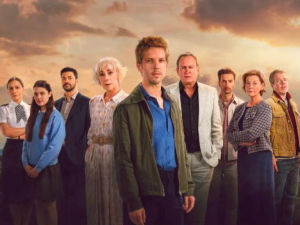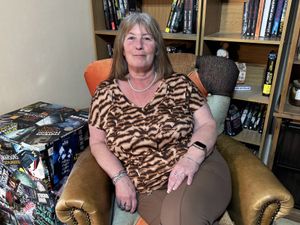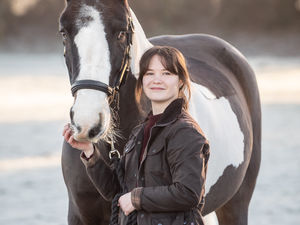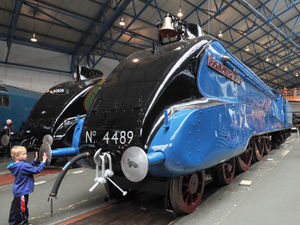Northern Ireland: A land of myths and fascination
Finn McCool has a lot to answer for.
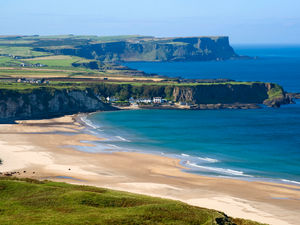
If it wasn’t for the angry, land-throwing giant, two of Northern Ireland’s most prized assets would not exist. And there would be no Isle of Man.
I’m floating on Lough Neagh and feeling grateful for the big man’s short temper and strength.
For it was here, 15 miles from Belfast that Finn scooped up some turf and hurled it out to sea during a ruck with a Scottish rival. The turf became the Isle of Man and the hole is now Lough Neagh. Or so the story goes.
With 150 square miles of water, Neagh is comfortably the UK’s largest lake and yet its reputation remains diminished. If ninth-generation fisherman Gary McErlean has his way this will soon change.
When he’s not catching eels, Gary is sharing his love for the shallow lake with the tourists drawn inland towards its shores. He skippers us across what looks like a sea but is only a small fraction of the lough, sharing stories from fighting Finn to how an English aristocrat archaically still owns the lough today.
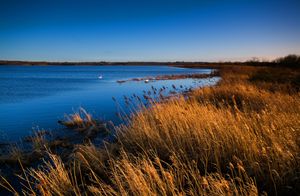
Gary and partner Ann-Marie are natural hosts - energetic and engaging despite daily 3am starts - and set up Lough Neagh Stories after realising the fishing they so love may not provide forever. As Ann-Marie explains why eel is the only food to tempt her out of vegetarianism, Gary manages to make a lake bigger than Paris feel like a friend. The couple help us understand that it’s the warmth of the company in Northern Ireland that makes it a must-visit destination.
That, and some of the best scenery the UK has to offer.
Within an hour of landing at Belfast International, we arrive at The Gobbins cliff path for our first dose. Advance warnings about steepness, steps and apparently needing the fitness level of a Gaelic footballer mean we are expecting to sweat. But we’re not expecting this to be due to the blazing sun.
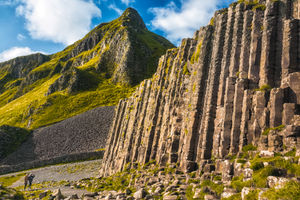
The downside of the heat is that we can’t quite see across to Britain as our guide leads us around jutting rocks, into plunging caves and alongside colonies of guillemots and seagulls - all within feet of a beautiful bright blue sea.
We leave regretful at not having time to explore the clifftop path above but soon learn that if you’re exploring the Causeway Coast, regret at being pushed for time is a feeling to get used to.
The route is a classic UK drive: winding roads, rugged clifftops, lush green fields and white sandy beaches.
The hurling pitch at Cushendall, one of the route’s several stunning villages, exemplifies its complementary beauty. Seawater below, hilltops above, fields, beach and murals beside.
Five miles north and Torr Head provides the drama and aggression otherwise lacking in such sunny calm weather.
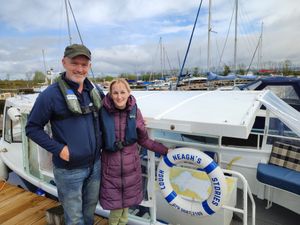
Tight turns, sharp drops and lanes so narrow that nearby curious lambs are risking their lives by poking their heads through the roadside fences. The rollercoaster road gets my heart pumping so fast I nearly forget to take in the view. But my, what a view. Thankfully we have free reign on the road and escape having to reverse. Perhaps our fellow tourists were given the parental guidance this road deserves.
Despite the competition, the headline act of this festival of countryside remains the Giant’s Causeway. Two to three hours’ drive from The Gobbins and 30 miles north of Lough Neagh, Finn McCool’s best-known creation is a true tourist magnet.
With evening spring sun still beating down, we opt for the two-mile clifftop walk before swooping down to sea level to follow in Finn’s footsteps.
After being seduced by the coastline elsewhere I’m initially underwhelmed gazing at the causeway from a distance, but once we step onto the pile of hexagonal organ-pipe pillars I’m won over. How can a rock formation so spectacular and so symmetrical not be man-made? No wonder the Finn McCool mythology has been so successful.
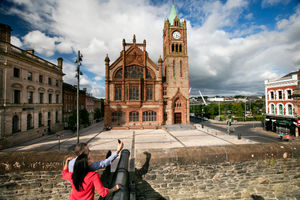
By the time we wake the next morning the sunshine of the day before is long forgotten. We are in the UK after all.
Thankfully Northern Ireland’s menu contains more than just outdoor offerings and being based at the elegant and central Ardtara Country House, we’re able to head anywhere with ease.
Our bellies bursting thanks to the hotel’s locally sourced fayre, we zip up our raincoats and head straight to Derry pondering one key question: what to call the place.
The answer, it seems, is whatever you like. Our tour guide Charlene prefers Legenderry, and does an excellent job of explaining why as she glides seamlessly from the siege of 1689 to the 20th century Troubles and the peaceful cultural hub the city is today.
Once thought of as a noose but now rightly known as a necklace, the thick Derry walls are the perfect place to begin to understand the city. From here we peer over the protestant Fountain neighbourhood with its pavements painted red, white and blue, gaze across to the Catholic Bogside with its Irish flags and murals and admire the beautiful sandstone bricks of the landmark Guildhall.
The city tells its rich, nuanced and often violent history excellently through a series of museums. We’re warmly welcomed at them all but it's the Museum of Free Derry that leaves the deepest mark.
The small but powerful exhibition shares the story of oppression, protest and conflict from a site in the centre of the Bloody Sunday slaughtering ground. We hear the voices of the victims, watch the first civil rights march and examine up-close artefacts that include the priest’s famous white handkerchief from that fateful Sunday.
And we have the privilege of meeting John Kelly, who shares a joke and a smile and recommends Derry’s boisterous jazz festival before telling the tragic story of how his 17-year-old brother was killed that day.
John sums up the city, and indeed the country. While once they were dominated by fortresses and fear, their key characteristics are now friendliness and fascination. We’re here at election time which means we’re constantly prodded by billboards shouting about borders and protocols. But the focus of everyone we meet is how to unite - not divide.
Our final morning is spent on the lough, which gives us just enough time to sneak in a visit to Titanic Belfast. The multi-million pound site is now 10 years old but remains a demonstration in how to run a modern museum. We feel the heat of the shipyard, lounge in the luxury of the decks and shiver as we hear the radio messages sent as the iceberg struck.
Alas we’ve flight to catch and thus have no time to stay and read every survivor’s story. As both a journalist and a history lover I could have stayed all day.
Our delays at Birmingham mean we arrive unnecessarily early at Belfast and end up sailing through security. This leaves time for one final Guinness and a toast to Northern Ireland, a country fully deserving of fame not just for its history and mythology but also for its friendship.
Important information about visiting Northern Ireland
How to get there:
Flights from Birmingham, Manchester and Liverpool take an hour with prices starting from £50 return.
The ferry from Birkenhead takes eight hours and costs upwards from £32.
How to get around:
Hiring a car is the best way to see the best of the coastal and inland areas. Major companies have outlets at both airports, with prices from around £40 per day.
Where to stay:
Bed and breakfast at Ardtara Country House from £112 per person or £147 including a three-course dinner. https://www.ardtara.com/.
When to visit:
It’s the UK, so aim for non-school holiday summer months where possible but always be prepared for every form of weather.
Find out more at ireland.com

